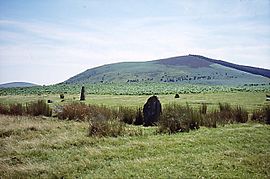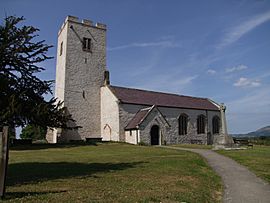Battle of Denbigh Green facts for kids
Quick facts for kids Battle of Denbigh Green |
|||||||
|---|---|---|---|---|---|---|---|
| Part of the First English Civil War | |||||||
 St Marcella's Church, also known as Whitchurch or Yr Eglwys Wen, which stood on Denbigh Green |
|||||||
|
|||||||
| Belligerents | |||||||
| Commanders and leaders | |||||||
| William Vaughan | Thomas Mytton Michael Jones |
||||||
| Strength | |||||||
|
|
||||||
| Casualties and losses | |||||||
| 100 killed 400 captured |
unknown | ||||||
The Battle of Denbigh Green happened on November 1, 1645. It was a key fight during the final part of the First English Civil War. This battle took place just outside the town of Denbigh in Wales. Many people say it was the most important battle in North Wales during the war.
In a last effort to help the important port city of Chester, a Royalist cavalry leader named Sir William Vaughan gathered about 2,000 soldiers. These soldiers came from different army bases in Shropshire and north-east Wales. They met at Denbigh Green. Before all his forces could arrive, a larger Parliamentarian army attacked them. This army was led by Thomas Mytton and Michael Jones. After a tough fight, the Royalist soldiers were defeated and scattered.
Contents
Why the Battle Happened: The Background
The War's Situation in 1645
By June 1645, the main Royalist army had been badly beaten at the Battle of Naseby. King Charles I and his supporters were mostly stuck in small army bases in western England and Wales. The King hoped to get more help from Ireland. To do this, he needed to hold onto the important port city of Chester. Lord Byron's Royalist army had been defending Chester since December 1644.
The Parliamentarian army began to seriously surround Chester again in September. This was led by Sir William Brereton. The Royalists tried to help the city, but they lost another battle at Rowton Heath on September 24. After this, King Charles told Sir William Vaughan to go back to Wales. Vaughan was an experienced cavalry (horse soldiers) leader. His job was to gather more soldiers for another try at helping Chester.
Royalist Soldiers Gather for Battle
Vaughan quickly started bringing soldiers together at Ludlow. They came from different army bases like Ludlow, Bridgnorth, and High Ercall. His group ended up having parts of at least ten different army units. However, the Royalists were running out of supplies, so their soldiers did not have good weapons. It was said that "scarcely a tenth man hath a pistol" among the horse soldiers.
By the middle of October, Vaughan might have had between 2,000 and 3,000 horse soldiers ready. He ordered all his foot soldiers to meet near Salesbury's Royalist base at Denbigh Castle.
The Parliamentarian leaders, Brereton, found out about Vaughan's soldiers marching north over Corndon Hill. Brereton ordered 1,500 horse soldiers and 1,500 foot soldiers from the Chester siege to stop them. These Parliamentarian forces were led by Colonel Michael Jones and Adjutant-General James Lothian. Jones reached Ruthin on October 30. There, Thomas Mytton, the main Parliamentarian commander for North Wales, took charge of all the troops.
Vaughan's first soldiers reached Chirk Castle on October 23. They picked up a few more foot soldiers there. Vaughan himself arrived by October 26. By October 31, Vaughan's army was camped on Denbigh Green. This was a large, open area of land outside the town. Here, he heard that Mytton had left Ruthin and was coming. Most of the soldiers Vaughan had ordered to meet him from other North Wales bases had not arrived yet. A volunteer with Vaughan, Richard Symonds, counted only 700 Royalist horse soldiers.
The next day, at noon, an alarm was sounded that Mytton's army was coming along the Ruthin road. Vaughan placed his musketeers (soldiers with muskets) and dragoons (soldiers who rode horses but fought on foot) along the hedges near St. Marcella's Church. This church was also called "Whitchurch." The main group of horse soldiers waited on open ground west of the road. Mytton responded by sending a small group of 40 musketeers ahead of his main army.
The Battle Begins at Denbigh Green
The battle started with Mytton's small group trying to push Vaughan's soldiers out of the hedges at Whitchurch. Symonds wrote that the Royalists "handsomely disputed" (fought well) for over an hour in the hedges and lane.
Mytton saw that his men "could not break in upon them" and were wasting time. So, he left his first group in place. He then moved the rest of his army around the side of the Royalists. This was a "laborious detour" (a long and difficult path) of several miles to reach Denbigh Green. This move made Vaughan pull back some of his soldiers to face the new threat. Once they were out of their strong defensive spots, the Royalist foot soldiers broke and ran towards Denbigh Castle. Salesbury later wrote that he let them into the castle, feeling sorry for their bravery.
Mytton then brought forward his Warwick and Derbyshire horse soldiers. They charged the Royalist cavalry. Vaughan managed to get his horse soldiers back together about two miles from the church on Denbigh Green. There, they were charged again. Some dragoons from the High Ercall base, helped by soldiers from Prince Maurice's special guard, charged back. They stopped Mytton's advance for a short time. But after a third charge, the Royalists finally broke and ran away.
The Parliamentarians chased the defeated Royalist horse soldiers for over 8 miles. More than 100 Royalists were killed, and 400 were captured. The rest were scattered into small groups. One group was finally caught at Llangernyw. The dead soldiers were buried in a large grave in the churchyard there. Vaughan and a big group of his men reached Llanrwst. They then stayed at Gwydir, the home of Richard Wynn, which they took supplies from.
While this was happening, Mytton took over the town of Denbigh. However, he did not have the right equipment to surround and take the castle. Salesbury continued to hold out in Denbigh Castle until October 1646. After completing his goal of scattering Vaughan's army, Mytton went back to continue the siege of Chester.
What Happened Next: The Aftermath
After Mytton left, Vaughan gathered his remaining soldiers at Denbigh. His foot soldiers rejoined him there. Then, they retreated south. Symonds wrote that they reached Newtown by November 10 and Knighton the next day. On November 12, the group split up. Prince Maurice's guards went to Bewdley. The Bridgnorth horse soldiers went there too. The rest of the soldiers went with Sir William Vaughan to Lemster.
Vaughan tried one last time to build up an army to help Chester. But with no supplies left, Lord Byron's forces in Chester had to surrender in January 1646. Vaughan then combined his remaining soldiers with those of Jacob Astley. This last strong Royalist army was finally defeated at the Battle of Stow-on-the-Wold in March.
Images for kids






